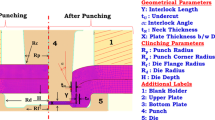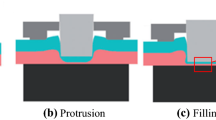Abstract
The present paper deals with the numerical modeling and experimental testing of the clinched joint formed by DX51D + AZ150 and AISI 430 material pairs. The strength of the joint was determined experimentally by the tension and shear tests. The numerical model developed for the analysis was successfully validated with the experimental data. The strength of the joint formed by alternative material pairs such as H340LAD + AZ150 and DX52D + Z275 is investigated numerically. The clinched joints between the tumble endplates and flange bodies were done according to the main findings from the previous steps. The study focuses on the strength of the clinched joint as an alternative to flange connection in the case of using different tumble endplate materials. It is concluded that the clinched joint formed by AISI 430 tumble endplate has the highest strength. In the need for tumble capacity increase without changing the design, it is recommended to use AISI 430 material for tumble endplate and to consider strength values of AISI 430 material for capacity control. On the other hand, in case of using three different tumble endplates for the same die, punch and process conditions, the tumble capacity should be evaluated by considering DX52D + Z275 material which has the lowest strength.

















Similar content being viewed by others
Abbreviations
- a :
-
The distance between tumble and pulley (millimeter)
- D 1 :
-
Pulley diameter (millimeter)
- D 2 :
-
Tumble diameter (millimeter)
- \(f\) :
-
Belt frequency (Hertz)
- F ay :
-
Back side support force (Newton)
- F ç :
-
Peripheral force (Newton)
- F kger :
-
Belt tight arm force (Newton)
- F kgev :
-
Belt slack arm force (Newton)
- F lw :
-
Weight of laundry considered for the fast life test (Newton)
- F oy1 :
-
Left front support force (Newton)
- F oy2 :
-
Right front support force (Newton)
- F t :
-
Belt tightness force (Newton)
- F tw :
-
Weight of the tumble group (Newton)
- k :
-
Belt centrifugal effect coefficient
- l :
-
Belt arm length (meter)
- L :
-
Belt length (meter)
- m rib :
-
Unit belt weight (kg/m/rib)
- n :
-
Pulley velocity (revolution per minute)
- n rib :
-
Number of layers in belt
- P :
-
Power transmitted (Watt)
- R 1 :
-
Pulley effective radius (millimeter)
- R 2 :
-
Tumble effective radius (millimeter)
- v :
-
Belt peripheral velocity (meter/second)
- \(\beta \) :
-
Contact angle (°)
- μ :
-
Belt friction coefficient
References
Chen C, Zhao S, Cui M, Han X, Ningyu B (2016) Numerical and experimental investigations of the reshaped joints with and without a rivet. Int J Adv Manuf Tech 88(5–8):2039–2051. https://doi.org/10.1007/s00170-016-8889-5
Carboni M, Beretta S, Monno M (2006) Fatigue behaviour of tensile-shear loaded clinched joints. Eng Fract Mech 73:178–190
Breda A, Coppieters S, Debruyne D (2017) Equivalent modelling strategy for a clinched joint using a simple calibration method. Thin-Walled Struct 113:1–12
Atia MKS, Jain MK (2018) Finite element analysis of material flow in die-less clinching process and joint strength assessment. Thin-Walled Struct 127:500–515
Lambiase F (2015) Mechanical behaviour of polymer–metal hybrid joints produced by clinching using different tools. Mater Des 87:606–618
Chen C, Zhao S, Cui M, Han X, Fan S (2016) Mechanical properties of the two-steps clinched joint with a clinch-rivet. J Mater Process Technol 237:361–370
Jiang T, Liu ZX, Wang PC (2015) Effect of aluminum pre-straining on strength of clinched galvanized SAE1004 steel-to-AA6111-T4 aluminum. J Mater Process Technol 215:193–204
Barnes T, Pashby I (2000) Joining techniques for aluminum spaceframes used in automobiles: part I-Solid and liquid phase welding. J Mater Process Technol 99(1):62–71
Gerstmann T, Awiszus B (2014) Recent developments in flat-clinching. Comput Mater Sci 81:39–44
Coppieters S, Lava P, Baes S, Sol H, VanHoutte P, Debruyne D (2012) Analytical method to predict the pull-out strength of clinched connections. Thin-Walled Struct 52:42–52
Su Z, Lin P, Lai W, Pan J (2015) Fatigue analyses of self-piercing rivets and clinch joints in lap-shear specimens of aluminum sheets. Int J Fatigue 72:53–65
Oudjene M, Ben-Ayed L (2008) On the parametrical study of clinch joining of metallic sheets using the Taguchi method. Eng Struct 30:1782–1788
Mucha J (2011) The analysis of lock forming mechanism in the clinching joint. Mater Des 32:4943–4954
Varis JP (2000) A novel procedure for establishing clinching parameters for high strength steel sheet, Dissertation, Lappeenranta University of Technology, Finland
Varis JP, Lepisto J (2003) A simple testing-based procedure and simulation of the clinching process using finite element analysis for establishing clinching parameters. Thin-Walled Struct 41:691–709
Hamela V, Roelandta JM, Gacelb JN, Schmit F (2000) Finite element modeling of clinch forming with automatic remeshing. Comput Struct 77:185–200
He X, Zhang Y, Xing B, Gu F, Ball A (2015) Mechanical properties of extensible die clinched joints in titanium sheet materials. Mater Des 71:26–35
Zhao D, Xu F, Guo JH, Han XL (2014) Experimental and numerical research for the failure behavior of the clinched joint using modified Rousselier models. J Mater Process Technol 214:2134–2145
Guo JH, Zhao SD, Murakami R, Zang SL (2013) Experimental and numerical investigation for ductile fracture of Al-alloy 5052 using modified Rousselier model. Comput Mater Sci 71:115–123
Lambiase F, Ilio AD (2016) Damage analysis in mechanical clinching: Experimental and numerical study. J Mater Process Technol 230:109–120
Jagtap KR, Ghorpade SY, Chopade SE (2017) finite element analysis of mechanical clinching process. Mater Today Proc 4:8104–8110
Chen C, Li Y, Zhai Z, Zhao S, Zhang P, Huang M, Li Y (2019) Comparative investigation of three different reforming processes for clinched joint to increase joining strength. J Manuf Process 45:83–91
Chen C, Li Y, Zhang H, Li Y, Pan Q, Han X (2020) Investigation of a renovating process for failure clinched joint to join thin-walled structures. Thin Wall Struct 151:106686. https://doi.org/10.1016/j.tws.2020.106686
Shi C, Yi R, Chen C, Peng H, Ran X, Zhao S (2020) Forming mechanism of the repairing process on clinched joint. J Manuf Process 50:329–335. https://doi.org/10.1016/j.jmapro.2019.12.025
Chen C, Zhao S, Cui M, Han X, Zhao X, Ishida T (2017) Effects of geometrical parameters on the strength and energy absorption of the height-reduced joint. Int J Adv Manuf Tech 90:3533–3541
Chen C, Ran X, Pan Q, Zhang H, Yi R, Han X (2020) Research on the mechanical properties of repaired clinched joints with different forces. Thin Wall Struct 152:106752
TS EN ISO 6892–1 (2010) Tension experiment for metallic material. TSI, Ankara, Turkey
https://www.engineeringtoolbox.com/friction-coefficients-d_778.html
Caligulu U, Turkmen M, Ozer A, Taskin M, Ozer M (2015) The fatigue strength of AISI 430–304 stainless steels welded by CO2 laser beam welding. Metallofiz Noveishie Tekhnol 37(6):839–852
Author information
Authors and Affiliations
Corresponding author
Ethics declarations
Conflict of interest
The authors declare that they have no conflict of interest.
Additional information
Technical Editor: Paulo de Tarso Rocha de Mendonça, Ph.D.
Publisher's Note
Springer Nature remains neutral with regard to jurisdictional claims in published maps and institutional affiliations.
Rights and permissions
About this article
Cite this article
Bayraktar, M., Cerkez, V. Experimental and numerical investigation of clinched joint and implementation of the results to design of a tumble dryer. J Braz. Soc. Mech. Sci. Eng. 42, 567 (2020). https://doi.org/10.1007/s40430-020-02622-w
Received:
Accepted:
Published:
DOI: https://doi.org/10.1007/s40430-020-02622-w




